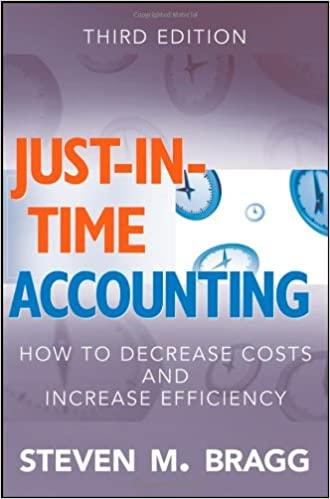Answered step by step
Verified Expert Solution
Question
1 Approved Answer
please full calculation and explanation. Specifically part 2. Containers, Inc. produced 62,500 and sold 59,000 plastic microcomputer cases at a selling price of $10.00 each.

please full calculation and explanation. Specifically part 2.
Containers, Inc. produced 62,500 and sold 59,000 plastic microcomputer cases at a selling price of $10.00 each. Manufacturing overhead is allocated on the basis of machine hours. The standard variable costs per computer case were: Quantity Total Direct Materials 1 5 kg $ 1.20 per kg $1.80 Direct Labour 0.50 labour hours $ 15.00 per hour 7.50 Variable Overhead 0.20 machine hours $6.00 per hour 1.20 Rate Information regarding fixed overhead includes the following: Budgeted Fixed Overhead: Denominator Used: Budgeted Production Volume Standard Machine Hours/Unit: Total Budgeted Machine Hours $337,500 Total Budgeted Direct Machine Hours 50,000 units 0.20 machine hours @ $ 1.21 per kg @ $ 14.70 per hour Data on Actual Costs and Quantities Direct material purchased Direct material used Direct labour incurred Machine Hours used Fixed Overhead Costs Variable Overhead Costs 103,125 kg 91,900 kg 30,300 hours 12,000 hours $340,200 $81,000 6.75 All inventory accounts had zero beginning balances. All of the work started this period was completed in the period REQUIRED: Part 1 1. Prepare a standard cost card for one microcomputer case 2. Calculate these variances: DM Price and Efficiency, DL Price (Rate) and Efficiency, 3. Journalize the following transactions: a DM purchase, including any related variance(s) b. DM requisitioned to production, including any related variance(s) c Labour costs incurred, including any related variances) Part II 4. Calculate these variances: Variable Overhead Spending and Efficiency, and Fixed Overhead Spending and Production Volume Variances 5. Journalize the following transactions: a. Actual variable overhead costs incurred b. Actual fixed overhead costs incurred C. The allocation of variable overhead to production d. The allocation of fixed overhead to production e. The isolation of variable overhead variances o f. The isolation of fixed overhead variances 6. Prepare the journal entry to close out all of the variance accounts, assuming that all variances are immediately expensed to cost of Goods Sold (and not prorated among the inventory accounts) Containers, Inc. produced 62,500 and sold 59,000 plastic microcomputer cases at a selling price of $10.00 each. Manufacturing overhead is allocated on the basis of machine hours. The standard variable costs per computer case were: Quantity Total Direct Materials 1 5 kg $ 1.20 per kg $1.80 Direct Labour 0.50 labour hours $ 15.00 per hour 7.50 Variable Overhead 0.20 machine hours $6.00 per hour 1.20 Rate Information regarding fixed overhead includes the following: Budgeted Fixed Overhead: Denominator Used: Budgeted Production Volume Standard Machine Hours/Unit: Total Budgeted Machine Hours $337,500 Total Budgeted Direct Machine Hours 50,000 units 0.20 machine hours @ $ 1.21 per kg @ $ 14.70 per hour Data on Actual Costs and Quantities Direct material purchased Direct material used Direct labour incurred Machine Hours used Fixed Overhead Costs Variable Overhead Costs 103,125 kg 91,900 kg 30,300 hours 12,000 hours $340,200 $81,000 6.75 All inventory accounts had zero beginning balances. All of the work started this period was completed in the period REQUIRED: Part 1 1. Prepare a standard cost card for one microcomputer case 2. Calculate these variances: DM Price and Efficiency, DL Price (Rate) and Efficiency, 3. Journalize the following transactions: a DM purchase, including any related variance(s) b. DM requisitioned to production, including any related variance(s) c Labour costs incurred, including any related variances) Part II 4. Calculate these variances: Variable Overhead Spending and Efficiency, and Fixed Overhead Spending and Production Volume Variances 5. Journalize the following transactions: a. Actual variable overhead costs incurred b. Actual fixed overhead costs incurred C. The allocation of variable overhead to production d. The allocation of fixed overhead to production e. The isolation of variable overhead variances o f. The isolation of fixed overhead variances 6. Prepare the journal entry to close out all of the variance accounts, assuming that all variances are immediately expensed to cost of Goods Sold (and not prorated among the inventory accounts)Step by Step Solution
There are 3 Steps involved in it
Step: 1

Get Instant Access to Expert-Tailored Solutions
See step-by-step solutions with expert insights and AI powered tools for academic success
Step: 2

Step: 3

Ace Your Homework with AI
Get the answers you need in no time with our AI-driven, step-by-step assistance
Get Started


